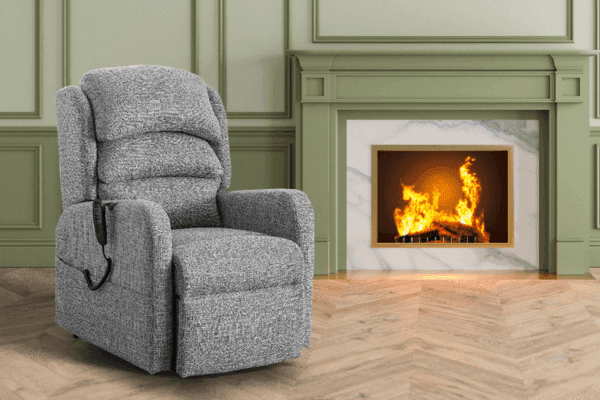
Living with sciatica can make sitting, resting, or even standing an uncomfortable experience. The pain, which often originates in the lower back and radiates down the leg, is usually caused by irritation or compression of the sciatic nerve. This nerve, the longest in the body, can become inflamed due to conditions like herniated discs, spinal stenosis, or prolonged poor posture.
A well-designed riser recliner chair can play a vital role in managing sciatica pain. Unlike standard chairs, which often lack lumbar support and put pressure on the lower spine, recliners for sciatica provide targeted support, help decompress the spine and assist with safe transitions between sitting and standing.
In this guide, we’ll walk you through the best features to look for, how they specifically help with sciatica and why investing in a supportive chair could significantly improve your daily comfort and mobility.
What Is Sciatica and Who Gets It?
Sciatica refers to pain that travels along the sciatic nerve, usually affecting one side of the body. The pain can range from a mild ache to a sharp, burning sensation and in severe cases, it can be debilitating
Causes of sciatica include:
- Herniated or slipped discs
- Spinal stenosis (narrowing of the spinal canal)
- Degenerative disc disease
- Muscle tightness or imbalance (especially in the lower back or glutes)
- Prolonged poor posture or sedentary lifestyle
Common symptoms:
- Sharp or radiating pain in the buttocks and leg
- Numbness or tingling in the foot or leg
- Lower back pain
- Difficulty sitting or standing for extended periods
Understanding these symptoms helps guide the selection of a chair that eases pressure and improves spinal alignment.
Why Your Seating Position Is Crucial
Sciatica pain often worsens with prolonged sitting — especially on firm, unsupportive surfaces. The wrong chair can compress spinal discs further and worsen nerve irritation.
A proper riser recliner, however, promotes:
- Spinal decompression
- Healthy seated posture
- Gentle elevation of legs (to relieve nerve pressure)
- Safe transition between sitting and standing
Therapeutic Recliner Features to Prioritize
Dual Motor Recline System
A dual motor recliner allows you to move the backrest and footrest independently, offering a highly customizable seating position.
How it helps:
- Reduces lower back strain by adjusting lumbar support separately
- Allows elevation of legs without reclining fully
- Enhances spinal alignment by enabling micro-adjustments
Zero-Gravity Positioning
Inspired by NASA, the zero-gravity setting elevates your feet to the same level as your heart. This position distributes body weight evenly and reduces stress on the lower spine.
How it helps:
- Alleviates pressure on the sciatic nerve
- Enhances circulation and reduces leg swelling
- Encourages muscle relaxation in the lower back
Orthopedic Memory Foam & Lumbar Cushioning
Orthopedic foam offers firm yet adaptive support that contours to your back, while lumbar cushions preserve the natural S-curve of your spine.
How it helps:
- Prevents slouching that exacerbates sciatica
- Minimizes pressure points on hips and lower back
- Supports long sitting sessions without discomfort
Heat and Massage Therapy
Built-in massage nodes and heat pads in the recliner target tense muscles and improve blood flow in the affected area.
How it helps:
- Reduces muscle tension surrounding the sciatic nerve
- Promotes tissue healing
- Provides soothing relief during flare-ups
Rise and Tilt Assistance
This function gradually shifts the chair forward, making it easier to stand up without straining the lower back or hips.
How it helps:
- Prevents sudden stress on the lumbar area
- Promotes independence for users with limited mobility
- Ideal for flare-ups when movement is difficult

Bonus Comfort Features to Consider
- Ergonomic remote controls with clear labeling
- Supportive, breathable fabrics that prevent overheating
- Wide armrests and a deep seat base for improved posture and support
Summary Table: Best Features for Sciatica Relief
| Feature | Benefit |
|---|---|
| Dual Motor Recline | Customized positioning to reduce nerve compression |
| Zero-Gravity Reclining | Spinal decompression and improved blood flow |
| Orthopedic Foam & Lumbar | Back contouring and postural support |
| Heat & Massage Therapy |
Eases tightness and promotes muscle recovery |
|
Rise & Tilt Mechanism |
Enables safe, low-impact standing |
Recommended Product: Adapt A Home Riser Recliner
The Riser Recliner from Adapt A Home is ideal for those with sciatica, featuring:
Dual motor system for full control, Zero-gravity recline, Plush orthopaedic support, Built-in lift function for safe transitions
Conclusion: Take Control of Your Comfort
Sciatica can be frustrating and limiting — but the right support system at home makes a big difference. A high-quality riser recliner offers more than just comfort: it provides spinal relief, supports movement and fosters a healthier posture over time.
Make a small change in your environment and you could see a big improvement in your daily well-being.


